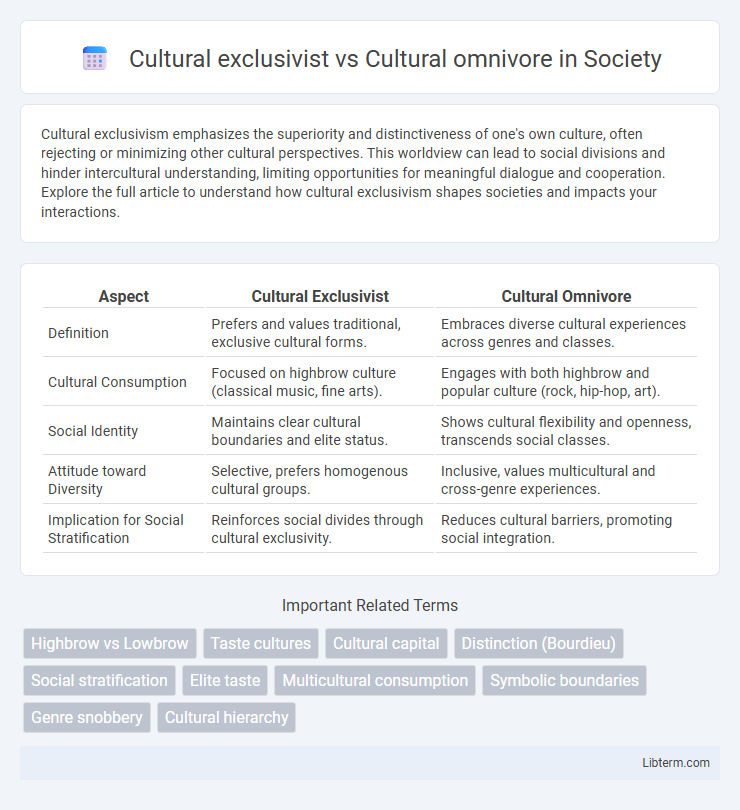Cultural exclusivism emphasizes the superiority and distinctiveness of one's own culture, often rejecting or minimizing other cultural perspectives. This worldview can lead to social divisions and hinder intercultural understanding, limiting opportunities for meaningful dialogue and cooperation. Explore the full article to understand how cultural exclusivism shapes societies and impacts your interactions.
Table of Comparison
| Aspect | Cultural Exclusivist | Cultural Omnivore |
|---|---|---|
| Definition | Prefers and values traditional, exclusive cultural forms. | Embraces diverse cultural experiences across genres and classes. |
| Cultural Consumption | Focused on highbrow culture (classical music, fine arts). | Engages with both highbrow and popular culture (rock, hip-hop, art). |
| Social Identity | Maintains clear cultural boundaries and elite status. | Shows cultural flexibility and openness, transcends social classes. |
| Attitude toward Diversity | Selective, prefers homogenous cultural groups. | Inclusive, values multicultural and cross-genre experiences. |
| Implication for Social Stratification | Reinforces social divides through cultural exclusivity. | Reduces cultural barriers, promoting social integration. |
Introduction to Cultural Exclusivism and Cultural Omnivorousness
Cultural exclusivism refers to the preference for and consumption of a narrow range of high-status cultural products, often emphasizing classical or traditional forms such as opera, classical music, and fine art. Cultural omnivorousness describes individuals who engage with a wide variety of cultural genres, blending highbrow and popular tastes across fields like literature, music, film, and cuisine. This contrast reflects differing patterns of cultural consumption that influence social identity, status, and access to cultural capital.
Historical Background of Cultural Consumption
Cultural exclusivism historically emerged from rigid class structures where cultural consumption was confined to elite highbrow tastes, reflecting social stratification and reinforcing exclusivity. In contrast, the cultural omnivore model gained prominence in late 20th-century sociology, highlighting a trend where upper and middle classes consume diverse cultural forms, including both popular and elite genres, signaling social openness and cultural capital diversification. This shift reflects broader societal changes such as globalization, increased access to education, and the breakdown of traditional class barriers in cultural participation.
Defining Cultural Exclusivist Attitudes
Cultural exclusivist attitudes prioritize traditional, high-status cultural forms and often reject popular or mass culture as less legitimate. These attitudes reflect a narrow consumption pattern, emphasizing classical music, fine arts, and elite literary works while dismissing contemporary or diverse cultural expressions. Research indicates that cultural exclusivism correlates with social stratification, reinforcing distinctions between dominant and marginalized groups based on cultural capital.
Understanding Cultural Omnivorous Tastes
Cultural omnivores exhibit diverse and eclectic taste profiles, actively embracing both highbrow and popular cultural forms, in contrast to cultural exclusivists who restrict their preferences to elite or traditional art forms. Understanding cultural omnivorous tastes involves analyzing patterns of consumption that cross social, economic, and ethnic boundaries, reflecting openness and cultural capital versatility. Research highlights that cultural omnivory correlates with higher education levels, urban residency, and globalized identities, showcasing the fluidity and inclusiveness of contemporary cultural engagement.
Social Factors Influencing Cultural Preferences
Social factors such as socioeconomic status, education level, and social networks heavily influence cultural preferences, shaping whether individuals align with cultural exclusivist or cultural omnivore tendencies. Cultural exclusivists often belong to social groups with restricted exposure and favor traditional or highbrow cultural forms, while cultural omnivores typically exhibit broader cultural consumption spanning diverse genres and styles due to their inclusive social environments and higher cultural capital. Urbanization and globalization also play crucial roles in expanding access to varied cultural experiences, enabling omnivorous cultural engagement across different social strata.
Cultural Exclusivism in Contemporary Society
Cultural exclusivism in contemporary society emphasizes the preservation of traditional cultural identities by limiting exposure to external influences and prioritizing heritage authenticity. This approach often manifests through resistance to globalization and the promotion of nationalistic or ethnic cultural practices, reinforcing social boundaries. Exclusive cultural consumption can contribute to social fragmentation by marginalizing diverse perspectives and restricting cross-cultural understanding.
The Rise of Cultural Omnivores
The rise of cultural omnivores reflects a shift from exclusivist consumption patterns to diverse cultural engagement, where individuals embrace a wide range of artistic genres and experiences. Cultural omnivores actively seek both highbrow and popular cultural forms, challenging traditional socio-economic boundaries tied to cultural tastes. This trend promotes cultural inclusivity and broadens access to varied artistic expressions, reshaping contemporary cultural landscapes and social identities.
Impacts on Social Stratification and Identity
Cultural exclusivists typically engage with a narrow range of cultural forms, reinforcing social boundaries and contributing to stronger in-group identity and clearer social stratification. In contrast, cultural omnivores consume diverse cultural experiences, which can blur traditional class distinctions and promote more fluid social identities. These differing cultural consumption patterns impact social mobility and the ways individuals negotiate status within complex social hierarchies.
Globalization and Shifting Cultural Boundaries
Cultural exclusivists tend to resist globalization by prioritizing traditional, homogeneous cultural expressions and maintaining strict boundaries around cultural identity. In contrast, cultural omnivores embrace globalization's fluidity, actively engaging with diverse cultural practices and blending elements from various traditions to create hybrid identities. This shift in cultural boundaries reflects a broader trend of increasing intercultural exchange and the erosion of rigid cultural divisions worldwide.
Future Trends in Cultural Consumption Patterns
Future trends in cultural consumption reveal a shift from cultural exclusivist tendencies, where individuals prefer specific, elite cultural forms, towards cultural omnivorism, characterized by diverse and eclectic cultural tastes spanning multiple genres and demographics. Data from global surveys indicate increasing engagement with cross-cultural content driven by digital platforms, leading to broader exposure and acceptance of varied cultural expressions. This evolution promotes inclusivity and challenges traditional cultural hierarchies, aligning with generational changes and advancements in media technology.
Cultural exclusivist Infographic

 libterm.com
libterm.com